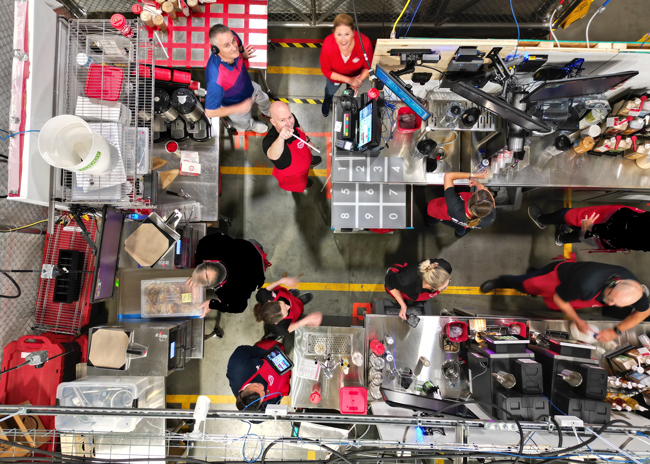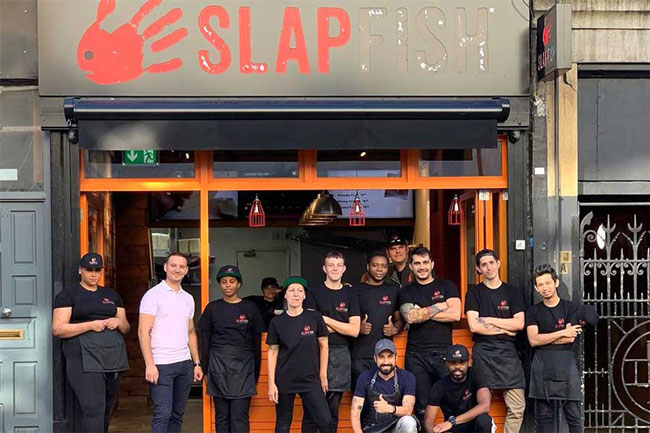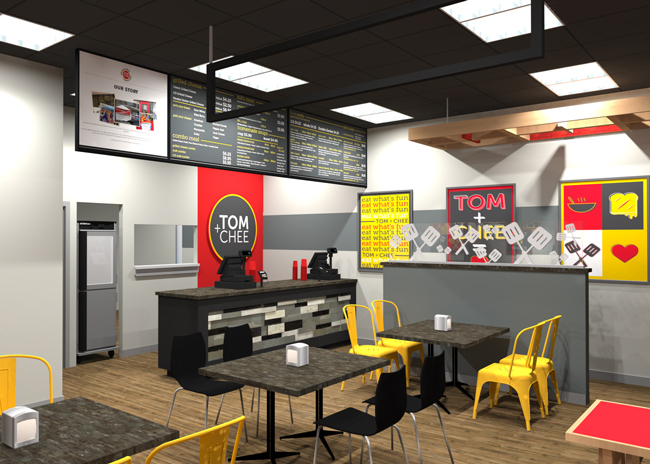McDonald's does it. Chick-fil-A does it, and now a much smaller operator, Scooter's Coffee, is doing it.
What it is, is operating an innovation lab.
In March Scooter's opened its Innovation Lab in Omaha, Neb., with the goal of being as efficient as possible, being more innovative, "and to underscore the emphasis we put on speed," says Nathan Lester, senior director of drive-thru innovation.
Scooter's has 638 stores, though "that number is changing every day," Lester says, and the company aims to have 1,000 stores sometime next year. "Our focus is speed so when we find efficiencies then you multiply that by a thousand, the business case is there," he says.
The chain has 523 drive-thru-only kiosks, which are just 664 square feet, and 115 traditional coffee shops. Scooter's serves thousands of customers daily so time matters. The goal of the Lab is to shave seconds off preparing each order, to build loyalty with guests.
Lester talks to rd+d about seven best practices for opening and operating an innovation lab.
 Scooter's opened its Innovation Lab in Omaha, Neb., in March 2023.
Scooter's opened its Innovation Lab in Omaha, Neb., in March 2023.
1. Make it easy to operate
Scooter's Innovation Lab is at its former headquarters, in a warehouse building that was previously used for storage. It's about 20 minutes away from the new headquarters, Lester says.
It didn't require a lot to convert the space, mostly taking down racks that were used to store materials and product. Scooter's wanted to make the space easy to operate so installed raceway grids overhead to run power and water to equipment, "to run different scenarios pretty quickly." All equipment is on casters so it's easy to move around, Lester says. Scooter's has only included equipment it would have in a typical store in order to replicate real-life scenarios.
2. Use it to test optimal layouts
Scooter's is using the Lab to test modular configurations. "It's plug-and-play so we can move things around and test things faster," says Lester. The idea is that the brand will run simulations side by side to test how one layout operates compared to another. These simulations are looking at "efficiency, speed, reducing the workload on a barista and ergonomics," Lester points out
3. Test for operations
Beyond the design of Scooter's locations, the next step for the Innovation Lab will be looking at operations. "Say we wanted to add a different step in the process, for a new product or in a different size, we can test it out in the Lab," says Lester.
Doing this in the Lab instead of a store, means real life operations are not affected, he says. "You can run it with that change and remove the other variables and see how it impacts the process. That information helps quickly build a business case to determine whether you want to keep the change or put it on a backburner."
For example, if Scooter's wanted to add whipped cream to a beverage or try a different way of adding whipped cream with new materials or a new machine, it could run different scenarios. It could also test out machines that are quicker, cheaper, smaller.
"We get inundated with manufacturers wanting us to try out different equipment. This allows us to quickly test things without committing to the equipment upfront." Scooter's can run tests like this in a day, Lester says.
4. Get other people involved
Scooter's has hired some new employees to work in the Innovation Lab but it's also a good way to involve people in other functions at the company, he says.
"Field training specialists, who train our new franchisees, are very well versed in existing brand standards and operations and bring tremendous value, so it's fun for them to come in and test new things out," Lester says. "There's value for innovation but also for the individuals to do something different, contribute differently to the success for everyone."
5. Build in technology
The Innovation Lab features cloud-based cameras that observe the lab remotely and can then be watched for learning. The cameras are on the overhead grid and can be repositioned anywhere.
Since they're connected to the internet "we can record simulations and then watch them to do time and motion studies, and see impacts on employees, such as ergonomics," Lester says. In addition, because these cameras are in the cloud, employees could participate or observe remotely, though that hasn't happened yet. That could be useful for someone from the training or operations departments, to understand how a change might impact store operations or store technology, he says.
 The Innovation Lab features cloud-based cameras that observe the lab remotely and can then be watched for learning. The cameras are on the overhead grid and can be repositioned anywhere.
The Innovation Lab features cloud-based cameras that observe the lab remotely and can then be watched for learning. The cameras are on the overhead grid and can be repositioned anywhere.
6. Take it to the real world
Lester knows testing in the Lab is just the first step and if something works there, it will be likely then tested in a real life store — either a corporate store or a franchise.
"The Lab environment is to remove as many variables as possible to see if it works in the store environments," he says. "But because of baristas, employees, customers, there's a pretty big human impact to processes and equipment so you can get some insight into that in the Lab."
The intent, he says, "is to eliminate risk as much as possible and we do that by testing in the Lab without the human elements we can't control."
7. Look back, as well as ahead
Since the Lab opened, Scooter's has realized it's very helpful for looking at its older stores, which often have different layouts and different equipment. "We can look at those legacy layouts and see how we can move things around and optimize for speed and hospitality without worrying about customer impacts. We don't want to leave any franchisees behind. So is there a way we can take learnings for the Lab and use them in the older stores?"


